Brute forcing your way to “default alive”
Brute forcing your way to “default alive”
Brute forcing your way to “default alive”
On brute-force growth and the "default alive" stories of some of the biggest product-led growth companies in the world in Retool, Atlassian, Tinder, Twilio, Algolia, Mmhmm, ClickUp, and Stripe
On brute-force growth and the "default alive" stories of some of the biggest product-led growth companies in the world in Retool, Atlassian, Tinder, Twilio, Algolia, Mmhmm, ClickUp, and Stripe
On brute-force growth and the "default alive" stories of some of the biggest product-led growth companies in the world in Retool, Atlassian, Tinder, Twilio, Algolia, Mmhmm, ClickUp, and Stripe



One of the most unforgiving places on the planet is the lowest of the five layers of the Amazon rainforest: the forest floor. Starved of sunlight, and crawling with predators, if you’re a plant sapling here, chances are you're not going to make it. Every inch is prime real estate and the competition to catch a ray of sunlight here is devoid of pity. By measure of competition alone, survival in the Amazon rainforests ranks right up there at the top as one of the most merciless endeavors one can undertake. Starting up in 2021 feels like a close second.
In 2021, venture capitalists invested more than $675 billion in startups worldwide, doubling the all-time high set in 2020. There were far more decacorns created in 2021 than in any prior year (30, as of November according to Crunchbase)- more than double the number set in 2020. The rainforest canopy is no doubt getting thicker and thicker.
These are the richest ecosystems in the world but the battle for survival on the forest floor is a street fight. Only the most tenacious and the most creative survive. Some climb up the trees and sprout leaves high up in the canopy. Some live off the air and water, high up on the branches.
And on the floor, only the fiercest strains emerge into the sunlight, wrestling the others out of the way to get there.
There are more start-ups in the world today than ever before. Competition is fiercer than ever and only the most tenacious and the most creative survive the scrap to emerge into the sun. The early days of the tallest redwoods of the tech world were no different: they cleared the ground with sheer brute force and an iron will.
🛠 Retool and the art of brute-forcing sales
Today, Retool helps companies like Mercedes-Benz, Doordash, ABInBev, Fox, NBC, and many others build internal tools, fast. They raised their Series C in December, bringing their valuation to $1.85B. Retool is growing, and growing fast.
Retool’s early days are a testament to how brute force outbound reach combined with a great product can soon hit escape velocity and take a company into orbit.
“The only way that you could learn about Retool [in the early days] was for me to email you and tell you about it.” - David Hsu, CEO & founder
For the first year and a half, Retool's growth was founder-led. Here's how they raced to over a million dollars in revenue in one year:
Step1: The team scoured Crunchbase pro to identify 10,000 targets that fit the description of the companies they wanted to introduce Retool to early on.
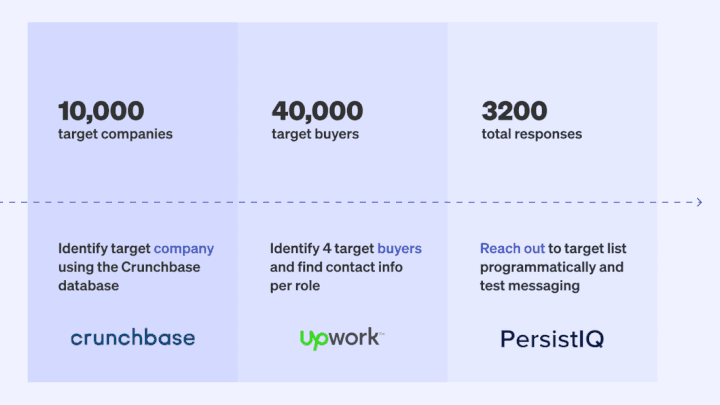
“Typically, if a company has raised money in the past 6 months, it means that they are looking to expand, grow, and operationalize what’s already been working,” says David.
Step2: The founding team used Upwork to convert the 10,000 targets into individuals at these companies, zeroing in on specific personas:
Head of Engineering Blog
VP of Engineering Blog
CTO
Head of Ops
The spreadsheet now had 40,000 names in it. Over the coming weeks, all of them were about to hear about Retool for the first time.
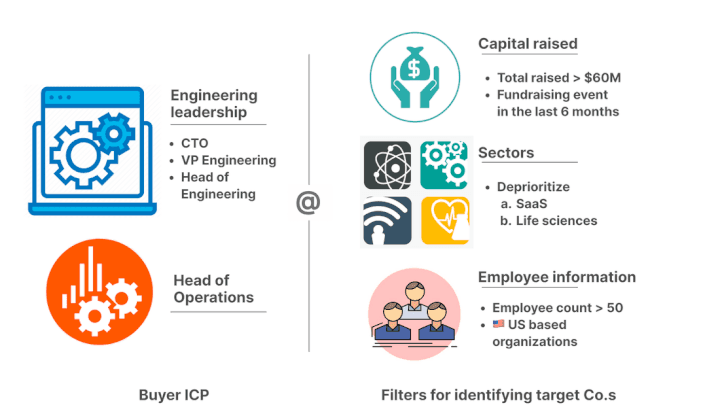
Step3: David turned to PersistIQ, a sales automation tool in order to reach out to the 40,000. After A/B testing a bunch of copies, the team finally found the subject line and messaging that worked and hit their inboxes.
At a conversion rate of 8%, they turned many of these responses into early adopters and even signed an enterprise customer pilot worth $1.5M! They hadn't made a single hire outside the founding team yet 🤯
📲 Twilio - ditch the slides, just show the world some tech
"We just started by treating developers like customers. It sounds really simple, but there’s a lot to it. Most companies who claim to serve developers actually don’t see developers as customers. They see them as a strategy. Developers aren’t customers for them. They’re like an audience that you try to win over in order to actually add more value to the company. And if it works, great. If it doesn’t, then you change strategies." - Jeff Lawson, Founder & CEO, Twilio
Today Twilio dominates the ‘Communications Platform as a service’ space. That SMS from Airbnb confirming your booking, the ETA alert informing you of your Uber driver's imminent arrival, and that Netflix invoice at the end of the month were likely all triggered by Twilio.
At a popular networking mixer called SF New Tech Meetup in 2010, rather than ramble on about a difficult to articulate communications infrastructure PowerPoint presentation, Jeff Lawson let the Twilio product speak for itself. In front of a crowd of 1000s, Jeff began telling the story of Twilio and its product while simultaneously coding up an application on a projected screen — a simple conference line. In a matter of seconds, he opened an account, got a phone number, had a conference line up and running, and asked everyone to phone in. And just like that, a throng of developers joined a giant conference call! Lawson then added a few more lines of simple code and retrofitted his app to call all participants back and thank them for participating in the demo. As phones throughout the room began buzzing simultaneously, the crowd went wild with enthusiasm! 🎉
Recognizing the power of a live demo - Twilio rolled out this playbook across 100s of developer conferences across the US, brute-forcing its way to word of mouth.
🍺 Atlassian - Can’t afford conference passes? Get your customers drunk instead!
Atlassian recognized that a large chunk of potential customers aggregated at tech conferences - like the JavaOne conference in San Francisco. However, booths cost anywhere between $20-50k - something Atlassian couldn't afford. Being the hacky 22-year-olds they were, Atlassian employed some guerilla tactics ahead of a popular session called “Java posse”. Prior to the event, Scott and Mike trucked in about 15 to 20 cases of beer for attendees and slapped Atlassian labels on them.
The free drinks were such a success that the speakers at the event gave Atlassian a great shout-out, the team got mentioned in a popular podcast, and for about $3000 of cost (beer), Atlassian scored booth space worth several 10s of thousands of dollars!
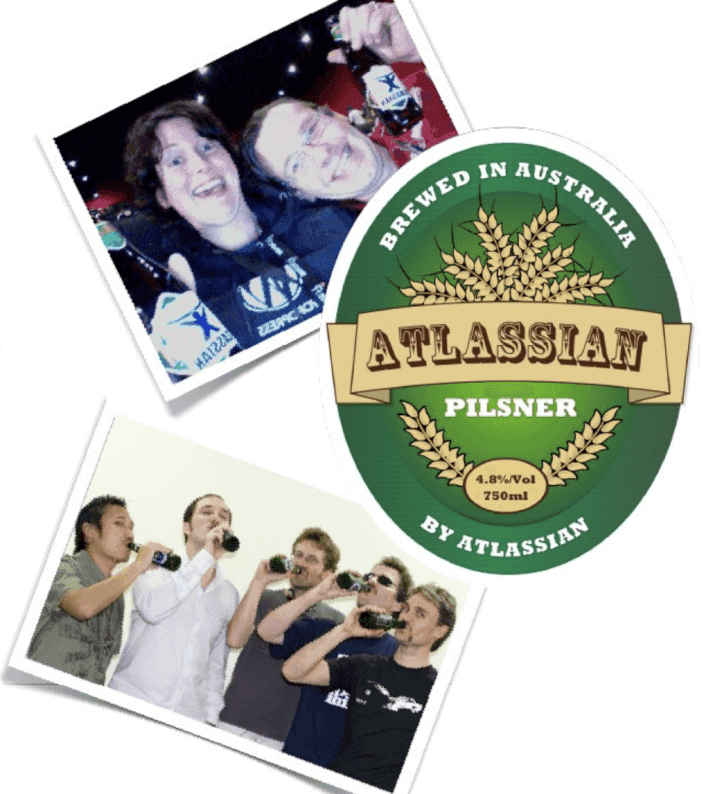
🎉Tinder - Throw parties! Again, and again, and again…
Network effects look magical from the outside. Almost like they always existed and always will. But most networks are “engineered”. They were crafted from a network of 1 to 2 to 4 … to a million nodes. And Tinder is a classic example of “engineered” network effects.
It all started when one of the founder’s (Justin) younger brother was throwing a birthday party for his best friend at USC. He had a bus going back and forth from USC to his parents' home/ A total of about 500 students. This is when the Tinder team had an idea, "Let's pay for the bus and call this a Tinder party." So they called the birthday girl and asked, "Can we make this a Tinder party? We'll spend money and make it bigger and better" and she was really excited about the idea. So Tinder paid for the bus and put a bouncer at the door and told every student that they couldn't walk in unless they downloaded Tinder. You'd literally have to show Tinder on your phone. So about 400 people downloaded Tinder at USC, none knowing what they’d really downloaded.
The party was an amazing success, and the next day, everyone at the party woke up and remembered they had a new app on their phone. There were attractive people they hadn’t gotten to talk to, and this was their second chance. The college party launch tactic worked. This one party created the highest ever one-day spike of downloads. Now 500 might seem modest - but these were 500 of the most social, hyperconnected people on campus. Overnight, Tinder started to work at USC. Next up, all the other universities in LA, the East Coast, Europe and eventually even South East Asia and India! Tinder growth hacked their way to network effects, one party at a time!
🆙 ClickUp - A blog post a day and a feature a week
Having decided not to raise funding in the early days, ClickUp’s growth from $0 to $20M ARR is a testament to their strong PLG flywheel. A flywheel that relied entirely on content for growth in the early days.
With $0 spent on marketing or sales, ClickUp relied entirely on content to attract their early users. Zeb Evans and team religiously pushed one post a day on the ClickUp blog, positioning ClickUp as an alternative to the status quo in the very crowded productivity space. They also relied on content to educate their users, and walk them through the platform - a platform that also took pride in pushing a new feature every week. The content was the fuel in the tank of ClickUp's organic growth engine driven by word-of-mouth, referrals, and organic traffic. Their SEO strategy cast a wide net targeting high intent short tail and long-tail keywords from users under many different verticals that ClickUp had brought under one roof.
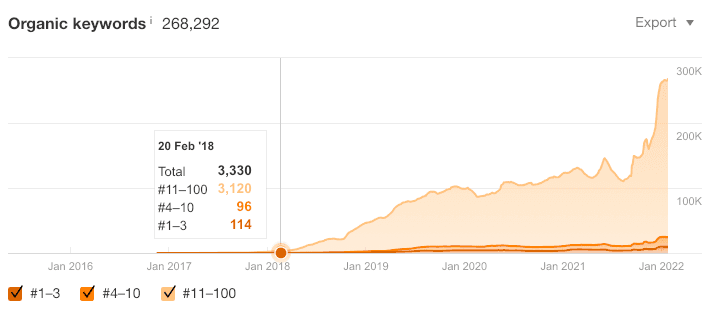
Today, ClickUp is a media agency masquerading as a productivity tool. With a blog post every day even today and a presence across social media platforms, ClickUp is one of the loudest B2B companies you are ever likely to find. From ongoing testimonials from power users ("ListenUp") to an Instagram series called "#ReturningToWork", a TikTok channel and long-form content pieces on productivity and remote work, the ClickUp media arm runs at full speed and round the year bringing in organic leads whose search intent is tied back to the product through content. "Work schooling", a video released as part of the #ReturningToWork series has over 2.3M views on YouTube.
The results speak for themselves:
"We first started creating value content over two years ago. Today, that free content nets ClickUp $12M in free clicks every month." - Zeb Evans, CEO
Algolia - Pretending to be San Fransiscan
Working out of their HQ in Paris, Algolia wanted to go after the big logos, and none were more valuable (and visible) than US logos. With the confidence that their US clients didn’t really care where they were based as long as they were available when needed, Gaëtan Gachet (Employee #4 and then VP of Business Development) and the team set out to conquer the US marketplace on French time. Algolia went the extra mile to bridge the perceived distance between San Francisco and the US. If you were a customer trying to reach someone in Algolia, you could do so at any point during your workday by calling their 415 (SF area code) number. What you wouldn’t have known was that you were reaching someone in Paris working PST hours on an SF number that had been set up on Aircall.
Algolia went the extra mile to bring San Francisco to Paris: they flew in reps from Atlanta to the Paris offices to add “some American blood” to the culture and banned French in open spaces. Every international hire was given a soundbox and the license to turn up the volume any time they heard someone speak French in the open.

💳 Stripe - Collison installations
The way you might have discovered a product back in 2010 was likely through an offer to try a beta, or a programmed sequence as part of an email campaign, a Hackernews launch or something of that strain. Unless this product was called Stripe. In the early days, the way you might have discovered Stripe was through either Patrick Collison or his brother John asking you for your laptop so they could set up Stripe for you. The Collison brothers pioneered this unscalable and highly unusual but effective technique for early user acquisition. They got to the point.
YCombinator startups building tools for other startups have the benefit of a large pool of other YC funded companies as potential customers, to begin with. As a YC company themselves, Stripe took full advantage. The Collison brothers collided head-on with their high CLTV customers. This took the Stripe rocket ship off the ground, coining the phrase: “Collison installations” and giving Stripe the reputation for aggressive early user acquisition that they hold even today.
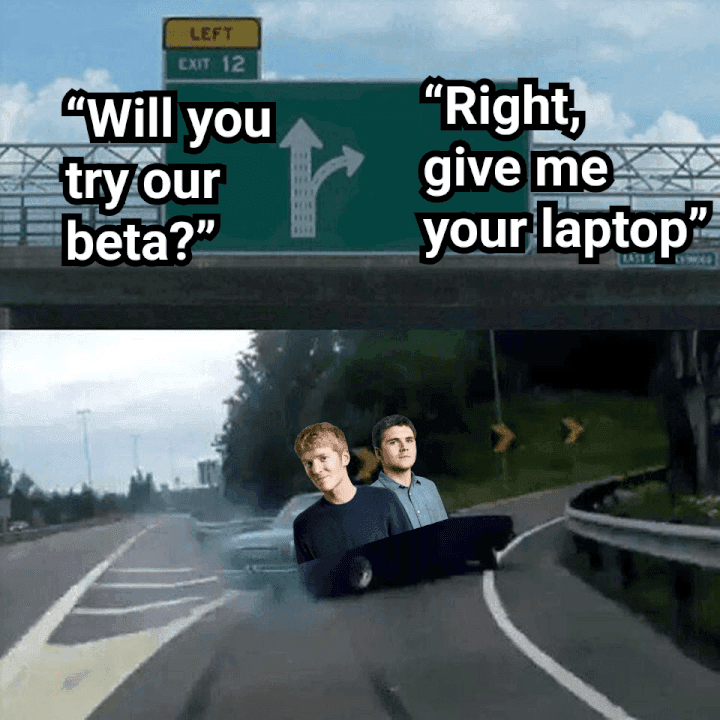
🖼 Hang the Mmhmm demo video in the Louvre
Most tools we use to communicate today lack the surface area for people to express themselves fully - the way they might in person. Mmhmm is a tool that attempts to solve this by adding another dimension to video calls.
The tool provides 'communication superpowers.' You can now add a second screen to your video, move across the screen, zoom in and out, and deploy a whole gamut of other cool features on your video calls.
Tasked with showcasing mmhmm’s arsenal of features while communicating the broader need for such a tool, and the larger mission, co-founder Phil Libin released a demo video. One thing was clear: He had understood the assignment. In the demo, Phil starts by describing the problem: “I’m really tired of living all day on video. It’s so easy to feel like an anonymous head in the box”, pitches the product and takes you through a showreel of mmhmm’s features.
The demo struck a chord with a world that was still adjusting to the realities of remote work and the video calls.
Here’s one of the best product demos ever created:
Released back when they were in early invite-only beta, the video has amassed 1.4 million views on youtube, creating a waitlist ~100k+ long.
🔁 Clearbit - Keep launching on ProductHunt
Clearbit released and promoted multiple free tools (and browser extensions) that provided standalone value. These tools doubled down as gateways to Clearbit, provided instant gratification, and by virtue of use cases solved were perfect destinations for paid marketing traffic.
Some of Clearbit’s launches on ProductHunt include:
Weekly Visitor Report - #5 Product of the Day
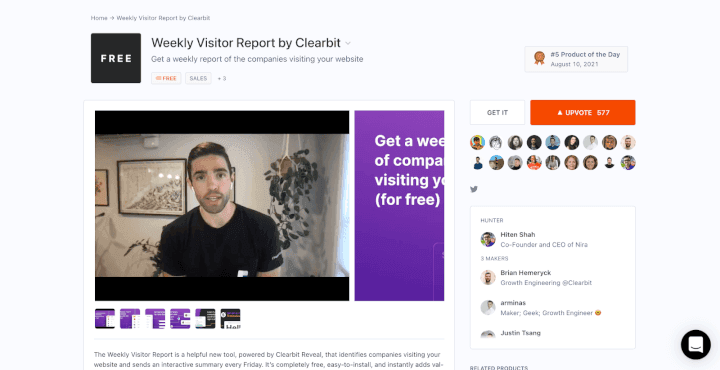
Clearbit’s Company Logo API - #2 Product of the Day
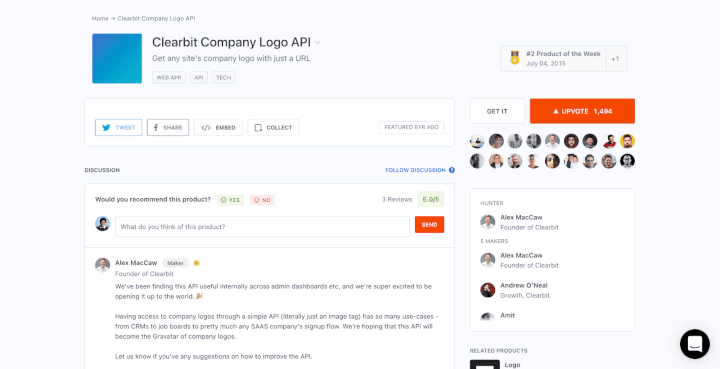
Clearbit connect - #5 Product of the Week
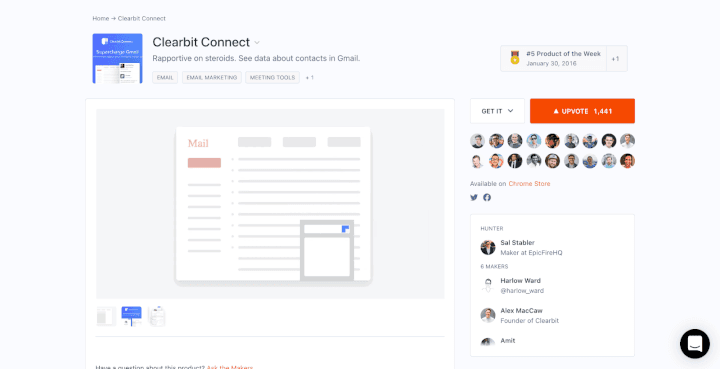
🦋 Young, Wild, and Free
One of the most common types of advice that Paul Graham gives at YCombinator is this: To do things that don’t scale.
“A good metaphor would be the cranks that car engines had before they got electric starters. Once the engine was going, it would keep going, but there was a separate and laborious process to get it going.”
For start-ups, there are unique advantages to being young, wild and free. They can grow and delight early customers in ways the bigger companies just cannot. And while that may not amount to much in the short term, the small wins begin to snowball and compound over time. The concept of compounding growth doesn't always register at the level of intuition but tracking metrics such as "weekly growth rate" can serve as good reminders of why the seemingly small and hard-fought wins can sometimes be highly valuable: another piece of advice founders often get at YC.
David Hsu and Retool will never have to do cold outbound again. You won’t find Atlassian smuggling beer into conferences these days. It doesn’t matter who you are today, it’s unlikely the Collison brothers will set up Stripe on your laptop. But back in their early days, as far as the Stripes, the Retools, and the Atlassians of the world were concerned, the only objective was to clear the forest floor, rise above the shrubbery, and grow shoots into the sun.
Even the tallest sequoia and redwoods one day emerged from a scrap on the forest floor.
One of the most unforgiving places on the planet is the lowest of the five layers of the Amazon rainforest: the forest floor. Starved of sunlight, and crawling with predators, if you’re a plant sapling here, chances are you're not going to make it. Every inch is prime real estate and the competition to catch a ray of sunlight here is devoid of pity. By measure of competition alone, survival in the Amazon rainforests ranks right up there at the top as one of the most merciless endeavors one can undertake. Starting up in 2021 feels like a close second.
In 2021, venture capitalists invested more than $675 billion in startups worldwide, doubling the all-time high set in 2020. There were far more decacorns created in 2021 than in any prior year (30, as of November according to Crunchbase)- more than double the number set in 2020. The rainforest canopy is no doubt getting thicker and thicker.
These are the richest ecosystems in the world but the battle for survival on the forest floor is a street fight. Only the most tenacious and the most creative survive. Some climb up the trees and sprout leaves high up in the canopy. Some live off the air and water, high up on the branches.
And on the floor, only the fiercest strains emerge into the sunlight, wrestling the others out of the way to get there.
There are more start-ups in the world today than ever before. Competition is fiercer than ever and only the most tenacious and the most creative survive the scrap to emerge into the sun. The early days of the tallest redwoods of the tech world were no different: they cleared the ground with sheer brute force and an iron will.
🛠 Retool and the art of brute-forcing sales
Today, Retool helps companies like Mercedes-Benz, Doordash, ABInBev, Fox, NBC, and many others build internal tools, fast. They raised their Series C in December, bringing their valuation to $1.85B. Retool is growing, and growing fast.
Retool’s early days are a testament to how brute force outbound reach combined with a great product can soon hit escape velocity and take a company into orbit.
“The only way that you could learn about Retool [in the early days] was for me to email you and tell you about it.” - David Hsu, CEO & founder
For the first year and a half, Retool's growth was founder-led. Here's how they raced to over a million dollars in revenue in one year:
Step1: The team scoured Crunchbase pro to identify 10,000 targets that fit the description of the companies they wanted to introduce Retool to early on.

“Typically, if a company has raised money in the past 6 months, it means that they are looking to expand, grow, and operationalize what’s already been working,” says David.
Step2: The founding team used Upwork to convert the 10,000 targets into individuals at these companies, zeroing in on specific personas:
Head of Engineering Blog
VP of Engineering Blog
CTO
Head of Ops
The spreadsheet now had 40,000 names in it. Over the coming weeks, all of them were about to hear about Retool for the first time.

Step3: David turned to PersistIQ, a sales automation tool in order to reach out to the 40,000. After A/B testing a bunch of copies, the team finally found the subject line and messaging that worked and hit their inboxes.
At a conversion rate of 8%, they turned many of these responses into early adopters and even signed an enterprise customer pilot worth $1.5M! They hadn't made a single hire outside the founding team yet 🤯
📲 Twilio - ditch the slides, just show the world some tech
"We just started by treating developers like customers. It sounds really simple, but there’s a lot to it. Most companies who claim to serve developers actually don’t see developers as customers. They see them as a strategy. Developers aren’t customers for them. They’re like an audience that you try to win over in order to actually add more value to the company. And if it works, great. If it doesn’t, then you change strategies." - Jeff Lawson, Founder & CEO, Twilio
Today Twilio dominates the ‘Communications Platform as a service’ space. That SMS from Airbnb confirming your booking, the ETA alert informing you of your Uber driver's imminent arrival, and that Netflix invoice at the end of the month were likely all triggered by Twilio.
At a popular networking mixer called SF New Tech Meetup in 2010, rather than ramble on about a difficult to articulate communications infrastructure PowerPoint presentation, Jeff Lawson let the Twilio product speak for itself. In front of a crowd of 1000s, Jeff began telling the story of Twilio and its product while simultaneously coding up an application on a projected screen — a simple conference line. In a matter of seconds, he opened an account, got a phone number, had a conference line up and running, and asked everyone to phone in. And just like that, a throng of developers joined a giant conference call! Lawson then added a few more lines of simple code and retrofitted his app to call all participants back and thank them for participating in the demo. As phones throughout the room began buzzing simultaneously, the crowd went wild with enthusiasm! 🎉
Recognizing the power of a live demo - Twilio rolled out this playbook across 100s of developer conferences across the US, brute-forcing its way to word of mouth.
🍺 Atlassian - Can’t afford conference passes? Get your customers drunk instead!
Atlassian recognized that a large chunk of potential customers aggregated at tech conferences - like the JavaOne conference in San Francisco. However, booths cost anywhere between $20-50k - something Atlassian couldn't afford. Being the hacky 22-year-olds they were, Atlassian employed some guerilla tactics ahead of a popular session called “Java posse”. Prior to the event, Scott and Mike trucked in about 15 to 20 cases of beer for attendees and slapped Atlassian labels on them.
The free drinks were such a success that the speakers at the event gave Atlassian a great shout-out, the team got mentioned in a popular podcast, and for about $3000 of cost (beer), Atlassian scored booth space worth several 10s of thousands of dollars!

🎉Tinder - Throw parties! Again, and again, and again…
Network effects look magical from the outside. Almost like they always existed and always will. But most networks are “engineered”. They were crafted from a network of 1 to 2 to 4 … to a million nodes. And Tinder is a classic example of “engineered” network effects.
It all started when one of the founder’s (Justin) younger brother was throwing a birthday party for his best friend at USC. He had a bus going back and forth from USC to his parents' home/ A total of about 500 students. This is when the Tinder team had an idea, "Let's pay for the bus and call this a Tinder party." So they called the birthday girl and asked, "Can we make this a Tinder party? We'll spend money and make it bigger and better" and she was really excited about the idea. So Tinder paid for the bus and put a bouncer at the door and told every student that they couldn't walk in unless they downloaded Tinder. You'd literally have to show Tinder on your phone. So about 400 people downloaded Tinder at USC, none knowing what they’d really downloaded.
The party was an amazing success, and the next day, everyone at the party woke up and remembered they had a new app on their phone. There were attractive people they hadn’t gotten to talk to, and this was their second chance. The college party launch tactic worked. This one party created the highest ever one-day spike of downloads. Now 500 might seem modest - but these were 500 of the most social, hyperconnected people on campus. Overnight, Tinder started to work at USC. Next up, all the other universities in LA, the East Coast, Europe and eventually even South East Asia and India! Tinder growth hacked their way to network effects, one party at a time!
🆙 ClickUp - A blog post a day and a feature a week
Having decided not to raise funding in the early days, ClickUp’s growth from $0 to $20M ARR is a testament to their strong PLG flywheel. A flywheel that relied entirely on content for growth in the early days.
With $0 spent on marketing or sales, ClickUp relied entirely on content to attract their early users. Zeb Evans and team religiously pushed one post a day on the ClickUp blog, positioning ClickUp as an alternative to the status quo in the very crowded productivity space. They also relied on content to educate their users, and walk them through the platform - a platform that also took pride in pushing a new feature every week. The content was the fuel in the tank of ClickUp's organic growth engine driven by word-of-mouth, referrals, and organic traffic. Their SEO strategy cast a wide net targeting high intent short tail and long-tail keywords from users under many different verticals that ClickUp had brought under one roof.

Today, ClickUp is a media agency masquerading as a productivity tool. With a blog post every day even today and a presence across social media platforms, ClickUp is one of the loudest B2B companies you are ever likely to find. From ongoing testimonials from power users ("ListenUp") to an Instagram series called "#ReturningToWork", a TikTok channel and long-form content pieces on productivity and remote work, the ClickUp media arm runs at full speed and round the year bringing in organic leads whose search intent is tied back to the product through content. "Work schooling", a video released as part of the #ReturningToWork series has over 2.3M views on YouTube.
The results speak for themselves:
"We first started creating value content over two years ago. Today, that free content nets ClickUp $12M in free clicks every month." - Zeb Evans, CEO
Algolia - Pretending to be San Fransiscan
Working out of their HQ in Paris, Algolia wanted to go after the big logos, and none were more valuable (and visible) than US logos. With the confidence that their US clients didn’t really care where they were based as long as they were available when needed, Gaëtan Gachet (Employee #4 and then VP of Business Development) and the team set out to conquer the US marketplace on French time. Algolia went the extra mile to bridge the perceived distance between San Francisco and the US. If you were a customer trying to reach someone in Algolia, you could do so at any point during your workday by calling their 415 (SF area code) number. What you wouldn’t have known was that you were reaching someone in Paris working PST hours on an SF number that had been set up on Aircall.
Algolia went the extra mile to bring San Francisco to Paris: they flew in reps from Atlanta to the Paris offices to add “some American blood” to the culture and banned French in open spaces. Every international hire was given a soundbox and the license to turn up the volume any time they heard someone speak French in the open.

💳 Stripe - Collison installations
The way you might have discovered a product back in 2010 was likely through an offer to try a beta, or a programmed sequence as part of an email campaign, a Hackernews launch or something of that strain. Unless this product was called Stripe. In the early days, the way you might have discovered Stripe was through either Patrick Collison or his brother John asking you for your laptop so they could set up Stripe for you. The Collison brothers pioneered this unscalable and highly unusual but effective technique for early user acquisition. They got to the point.
YCombinator startups building tools for other startups have the benefit of a large pool of other YC funded companies as potential customers, to begin with. As a YC company themselves, Stripe took full advantage. The Collison brothers collided head-on with their high CLTV customers. This took the Stripe rocket ship off the ground, coining the phrase: “Collison installations” and giving Stripe the reputation for aggressive early user acquisition that they hold even today.

🖼 Hang the Mmhmm demo video in the Louvre
Most tools we use to communicate today lack the surface area for people to express themselves fully - the way they might in person. Mmhmm is a tool that attempts to solve this by adding another dimension to video calls.
The tool provides 'communication superpowers.' You can now add a second screen to your video, move across the screen, zoom in and out, and deploy a whole gamut of other cool features on your video calls.
Tasked with showcasing mmhmm’s arsenal of features while communicating the broader need for such a tool, and the larger mission, co-founder Phil Libin released a demo video. One thing was clear: He had understood the assignment. In the demo, Phil starts by describing the problem: “I’m really tired of living all day on video. It’s so easy to feel like an anonymous head in the box”, pitches the product and takes you through a showreel of mmhmm’s features.
The demo struck a chord with a world that was still adjusting to the realities of remote work and the video calls.
Here’s one of the best product demos ever created:
Released back when they were in early invite-only beta, the video has amassed 1.4 million views on youtube, creating a waitlist ~100k+ long.
🔁 Clearbit - Keep launching on ProductHunt
Clearbit released and promoted multiple free tools (and browser extensions) that provided standalone value. These tools doubled down as gateways to Clearbit, provided instant gratification, and by virtue of use cases solved were perfect destinations for paid marketing traffic.
Some of Clearbit’s launches on ProductHunt include:
Weekly Visitor Report - #5 Product of the Day

Clearbit’s Company Logo API - #2 Product of the Day

Clearbit connect - #5 Product of the Week

🦋 Young, Wild, and Free
One of the most common types of advice that Paul Graham gives at YCombinator is this: To do things that don’t scale.
“A good metaphor would be the cranks that car engines had before they got electric starters. Once the engine was going, it would keep going, but there was a separate and laborious process to get it going.”
For start-ups, there are unique advantages to being young, wild and free. They can grow and delight early customers in ways the bigger companies just cannot. And while that may not amount to much in the short term, the small wins begin to snowball and compound over time. The concept of compounding growth doesn't always register at the level of intuition but tracking metrics such as "weekly growth rate" can serve as good reminders of why the seemingly small and hard-fought wins can sometimes be highly valuable: another piece of advice founders often get at YC.
David Hsu and Retool will never have to do cold outbound again. You won’t find Atlassian smuggling beer into conferences these days. It doesn’t matter who you are today, it’s unlikely the Collison brothers will set up Stripe on your laptop. But back in their early days, as far as the Stripes, the Retools, and the Atlassians of the world were concerned, the only objective was to clear the forest floor, rise above the shrubbery, and grow shoots into the sun.
Even the tallest sequoia and redwoods one day emerged from a scrap on the forest floor.
Related Articles




Generative AI: And the winner is...
Predicting who takes home the generative AI crown (and how)




Propensity Models in Sales: What You Need to Know
The only guide you'll need to understand what propensity models are in sales, the types of propensity models, their use cases, and how to implement them.




Lead Grading Essentials: The B2B Sales Guide
The only guide you'll need to understand lead grading essentials.
Copyright © Toplyne Labs PTE Ltd. 2024
Copyright © Toplyne Labs PTE Ltd. 2024
Copyright © Toplyne Labs PTE Ltd. 2024
Copyright © Toplyne Labs PTE Ltd. 2024